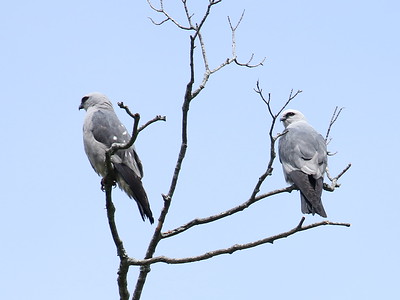2 MISSISSIPPI KITES were seen nest-building in Stratham on June 14th, and 1 was seen in Newmarket on the 19th.
Along the Connecticut River Valley, 2 BLACK VULTURES were seen in Hinsdale on June 19th, 2 were seen in Westmoreland on the 18th, and 1 was seen in Walpole on the 13th. Also, a BLACK VULTURE was seen at the Wright Farm in Atkinson on the 14th.

An ACADIAN FLYCATCHER was seen at the Contoocook River Park in Penacook on June 14th, and 1 was seen along the Ferry Way Trail at the Great Bay National Wildlife Refuge in Newington on June 15th.
A CLAY-COLORED SPARROW was reported from Pittsburg on June 18th.
A HOODED WARBLER was discovered along Antrim Road in Hancock on June 16th.
A female KING EIDER continues to be seen in coastal Rye, often from the second pullout just south of Odiorne Point State Park, and it was last reported on June 18th.
2 LEAST BITTERNS were seen at the Rockingham Recreational Rail Trail in Newfields on June 19th, and 1 was reported from World End Pond in Salem on June 16th.
A YELLOW-CROWNED NIGHT-HERON was seen at North Mill Pond in Portsmouth on June 19th.
4 AMERICAN OYSTERCATCHERS, a RED KNOT, and an ARCTIC TERN were seen at the Isles of Shoals during the past week.
A DUNLIN was seen at Hampton Beach State Park on several days during the past week.
A BLACK-LEGGED KITTIWAKE that was first reported from Pleasant Lake in New London on June 11th, has continued to be seen, and was last reported on the 19th. Also, 2 BLACK TERNS were reported from here on the 17th, and a GREATER YELLOWLEGS was seen here on the 12th and 13th.
A LESSER BLACK-BACKED GULL was photographed at Hampton Beach State Park on June 13th.
2 PHILADELPHIA VIREOS were reported from the Wildcat Mountain Ski Area, 1 was reported from Scott Bog Road in Pittsburg, and 1 was reported from East Inlet in Pittsburg, all at breeding territories during the past week.
A flock of 49 RED CROSSBILLS was seen between Winslow State Park and Kearsarge Valley Road on June 18th, a flock of 18 was seen at the Gunstock Mountain Resort on June 15th, and a flock of 10 was reported from Mount Monadnock on June 18th. In addition, there were numerous reports of small flocks of 1-3 RED CROSSBILLS during the past week, mostly from the southwestern highlands.
A territorial GOLDEN-WINGED WARBLER was seen along East Weare Road in Weare on the Everett Dam Conservation Lands on May 14th and was most recently reported on June 18th. It was in an overgrown field near some old Jersey-barriers approximately 1-mile west of the intersection of East Weare Road and South Sugar Hill Road. The bird sings a song similar to a BLUE-WINGED WARBLER type song.
A hybrid of a GOLDEN-WINGED WARBLER crossed with a BLUE-WINGED WARBLER was seen and heard in Moody Park in Claremont on June 14th.
A MOURNING WARBLER was seen at the headwaters of Granite Lake in Stoddard on June 18th.
A few FOX SPARROWS were seen in the White Mountains during the past week.
2 FISH CROWS were reported from Holderness on June 19th.
This message is also available by phone recording: call (603) 224-9909 and press 4 as directed or ask to be transferred. If you have seen any interesting birds recently, you can leave a message at the end of the recording or send your sightings to the RBA via email. Please put either “bird sighting” or “Rare Bird Alert” in the subject line and be sure to include your mailing address and phone number.
Thanks very much and good birding.
Subscribe to New Hampshire Bird Records – learn more about birds and birding in New Hampshire (read a free article in each issue). This quarterly publication is produced by NH Audubon thanks to the work of many volunteers.
